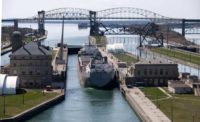Legislation authorizing new Army Corps of Engineers projects—and funds to upgrade the Flint, Mich., lead-tainted water system—has advanced on Capitol Hill with the House’s strong approval of a new water resources measure.
The Water Resources Development Act (WRDA), which the House passed by a convincing 399-25 vote on Sept. 28, authorizes about $9 billion for 31 Corps flood protection, harbor dredging, environmental restoration and other projects that received favorable reports from the Army’s Chief of Engineers.
The House measure next must be reconciled with a much more wide-ranging bill that the Senate passed on Sept. 15, by a resounding 95-3 vote. The two bills’ lists of Corps projects are nearly identical. But the toughest question is whether the House will accept at least some of the Senate version’s provisions authorizing several billion dollars of Environmental Protection Agency drinking water and wastewater treatment programs.
The House bill’s only non-Corps funding provision is $170 million for Flint drinking water, and it took tough, eleventh-hour bipartisan negotiations to get even that language into the measure. The Senate bill includes the $170 million, but additional drinking water provisions, too.
Mark W. Woodson, American Society of Civil Engineers president, said in a statement that the final bill must include such items as the Senate measure’s new trust fund for wastewater treatment projects. That isn’t in the House version.
Despite the burst of WRDA action this month, infrastructure advocates will have to wait until after the election for the House-Senate conference to formally convene. Congress is about to take a break within the next day or two until after the Nov. 8 election. It would not be surprising, however, for House and Senate staffers to meet over the recess period for some pre-conference discussions.
Engineering and construction industry groups, unsurprisingly, praised the House’s strong vote for what is one of the most important infrastructure measures in the current Congress.
They know, however, that the authorizations in the WRDA bills also are subject to annual appropriations. Many projects authorized in past WRDAs still lack appropriations.
Still, the House vote is a definite sign of progress. Lawmakers and industry organizations pointed out that, if a WRDA becomes law this year, it would mark a return to a past practice of biennial water resources measures. The last WRDA was signed in 2014, but the previous one became law in 2007.
The House bill’s prime architect, Transportation and Infrastructure Committee Chairman Bill Shuster (R-Pa.), said in a statement, “Enacting a WRDA bill every two years is essential to maintaining an efficient transportation system, moving commerce effectively and promoting economic growth throughout the country.”
Major waterways and industrial groups also hailed the port and river projects contained in the new WRDA. Waterways Council Inc. noted three projects it sees as priorities are in the House and Senate WRDAs: river lock modifications in Louisiana; a harbor dredging in Texas; and a study of expanded locks on the Ohio River near Pittsburgh.
Thomas J. Gibson, American Iron and Steel Institute president and CEO, said in a statement, “Our nation’s seaports are heavily congested and not dredged to full capacity, while our inland waterways include obsolete and aging infrastructure that often results in costly delays.”





Post a comment to this article
Report Abusive Comment